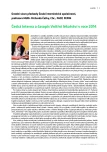The emerging pathogenesis-based strategies for treating sepsis
Authors:
Lenka Ledvinová; Vojtěch Danihel; Martin Matějovič
Authors‘ workplace:
Biomedicínské centrum LF UK, Plzeň
; I. interní klinika LF UK a FN Plzeň, přednosta prof. MUDr. Martin Matějovič, Ph. D.
Published in:
Vnitř Lék 2014; 60(1): 68-72
Category:
Reviews
Overview
The cornerstones of therapy for sepsis and septic shock remain the prompt and adequate hemodynamic resuscitation, administration of antibiotics that target the pathogen, removal or drainage of an infected source and organ support. Despite adequate treatment and advanced life-support, the mortality remains high. However, the development of adjunctive anti-sepsis therapies has been challenging, with more than 30 unsuccessful drug trials. Fortunately, recent advances in our understanding of the sepsis pathophysiology revealed new pathogenic paradigms, and, thus, provided new exciting therapeutic concepts. In this review, we briefly discuss emerging pathogenesis-based strategies for treating severe sepsis and septic shock.
Key words:
extracorporeal purification methods – immunosuppression – pathogenesis – sepsis – sepsis treatment
Sources
1. Xiao W, Mindrinos MN, Seok J et al. A genomic storm in critically injured humans. J Exp Med 2011; 208(13): 2581–2590.
2. Cinel I, Opal SM. Molecular biology of inflammation and sepsis: a primer. Crit Care Med 2009; 37(1): 291–304.
3. Cruz DN, Antonelli M, Fumagalli R et al. Early use of polymyxin B hemoperfusion in abdominal septic shock: the EUPHAS randomized controlled trial. JAMA 2009; 301(23): 2445–2452.
4. Davies B, Cohen J. Endotoxin removal devices for the treatment of sepsis and septic shock. Lancet Infect Dis 2011; 11(1): 65–71.
5. Opal SM, Laterre PF, Francois B et al. Effect of eritoran, an antagonist of MD2-TLR4, on mortality in patients with severe sepsis: the ACCESS randomized trial. JAMA 2013; 309(11): 1154–1162.
6. Denk S, Perl M, Huber-Lang M. Damage - and pathogen-associated molecular patterns and alarmins: keys to sepsis? Eur Surg Res 2012; 48(4): 171–179.
7. Yang H, Tracey KJ. Targeting HMGB1 in inflammation. Biochim Biophys Acta 2010; 1799(1–2): 149–156.
8. Charchaflieh J, Wei J, Labaze G et al. The role of complement system in septic shock. Clin Dev Immunol 2012; 2012 : 407324.
9. Bosmann M, Ward PA. The inflammatory response in sepsis. Trends Immunol 2013; 34(3): 129–136.
10. Souto FO, Alves-Filho JC, Turato WM et al. Essential role of CCR2 in neutrophil tissue infiltration and multiple organ dysfunction in sepsis. Am J Respir Crit Care Med 2011; 183(2): 234–242.
11. Tracey KJ. Physiology and immunology of the cholinergic antiinflammatory pathway. J Clin Invest 2007; 117(2): 289–296.
12. Sýkora R, Chvojka J, Kroužecký A et al. Hemoeliminační metody v léčbě sepse: současný stav. Vnitř Lék 2008; 54(10): 1000–1005.
13. Payen D, Mateo J, Cavaillon JM et al. Impact of continuous venovenous hemofiltration on organ failure during the early phase of severe sepsis: a randomized controlled trial. Crit Care Med 2009; 37(3): 803–810.
14. Rimmelé T, Kellum JA. Clinical review: blood purification for sepsis. Crit Care 2011; 15(1): 205.
15. Sykora R, Chvojka J, Krouzecky A et al. High versus standard-volume haemofiltration in hyperdynamic porcine peritonitis: effects beyond haemodynamics? Intensive Care Med 2009; 35(2): 371–380.
16. Sykora R, Chvojka J, Krouzecky A et al. Coupled plasma filtration adsorption in experimental peritonitis-induced septic shock. Shock 2009; 31(5): 473–480.
17. Muriová K, Maláska J, Otevrel F et al. Myocardial dysfuncition in sepsis – definition and pathogenetic mechanisms. Vnitř Lék 2010; 56(3): 220–225.
18. Stahl W, Matejovic M, Radermacher P. Inhibition of nitric oxide synthase during sepsis: revival because of isoform selectivity? Shock 2010; 34(3): 321–322.
19. Singer M. Mitochondrial function in sepsis: acute phase versus multiple organ failure. Crit Care Med 2007; 35(9, Suppl): 441–448.
20. Ruggieri AJ, Levy RJ, Deutschman CS. Mitochondrial dysfunction and resuscitation in sepsis. Crit Care Clin 2010; 26(3): 567–575.
21. Boomer JS, To K, Chang KC et al. Immunosuppression in patients who die of sepsis and multiple organ failure. JAMA 2011; 306(23): 2594–2605.
22. Hotchkiss RS, Monneret G, Payen D. Immunosuppression in sepsis: a novel understanding of the disorder and a new therapeutic approach. Lancet Infect Dis 2013; 13(3): 260–268.
23. Karvunidis T, Lysák D, Chvojka J et al. Imunitní homeostáza (deregulace?) v sepsi a septickém šoku. Anesteziologie a intenzivní medicína 2013; 24(4): 250–263.
24. Peters E, van Elsas A, Heemskerk S et al. Alkaline phosphatase as a treatment of sepsis-associated acute kidney injury. J Pharmacol Exp Ther 2013; 344(1): 2–7.
Labels
Diabetology Endocrinology Internal medicineArticle was published in
Internal Medicine

2014 Issue 1
Most read in this issue
- Effect of alcohol consumption on cardiac electrophysiology
- Familiar Mediterranean fever in Czech Republic
- Familial Mediterranean Fever – clinical picture, diagnosis and treatment
- Familial Mediterranean Fever – First Experiences in Slovakia
